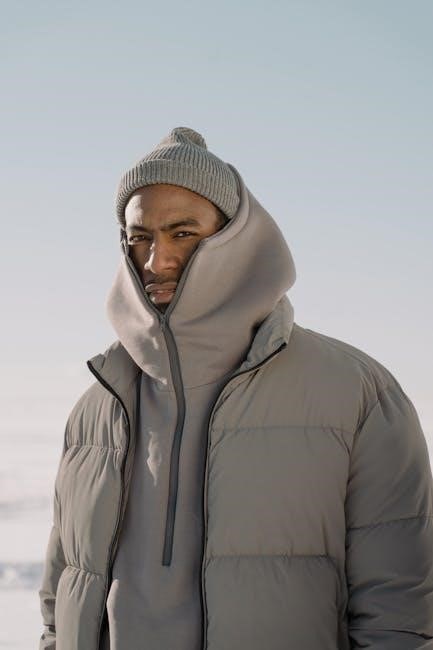Welcome to our comprehensive guide on men’s hoodie sizing. Proper fit is key for style and comfort. This guide helps you choose the right size effortlessly.

Understanding the Importance of Proper Fit
A well-fitting hoodie is essential for both style and comfort. Proper fit ensures ease of movement and avoids restrictive or bulky clothing. It enhances the overall aesthetic‚ making the garment look tailored to your body. A hoodie that fits correctly prevents excessive fabric bunching or sagging‚ which can be unflattering. Additionally‚ proper fit impacts durability‚ as ill-fitting clothes may experience more wear and tear. For different body types‚ the right fit can create a balanced silhouette‚ whether you prefer slim‚ regular‚ or oversized styles. Fabric type also influences how a hoodie drapes on your body‚ so considering material is crucial. Ultimately‚ a proper fit boosts confidence‚ ensuring you look and feel great in your hoodie. It’s a key factor in making your purchase worthwhile and enjoyable to wear.

Key Measurements for Determining Hoodie Size
Chest size‚ body length‚ and sleeve length are the primary measurements for determining hoodie size. Accurate measurements ensure a comfortable and flattering fit‚ essential for any hoodie style.
How to Measure Chest Size Accurately
To measure your chest size accurately‚ wrap a flexible tape measure around the widest part of your chest‚ typically just under your armpits. Keep the tape level and not too tight or loose. Ensure you’re wearing a slim-fit shirt or no shirt for the most precise measurement. The tape should pass across the center of your chest‚ parallel to the floor. Round the measurement to the nearest whole number to determine your size. For example‚ if your chest measures 40 inches‚ you likely fall into a Large size. Accurate chest measurements are crucial for ensuring a comfortable and flattering fit‚ whether you prefer slim-fit‚ regular-fit‚ or oversized hoodies. This step is foundational for selecting the right size from any brand’s size chart. Proper measurement avoids the hassle of returns and ensures optimal comfort and style.
How to Measure Body Length for Hoodies
To measure your body length for a hoodie‚ stand upright and place the tape measure at the base of your neck‚ just above the collarbone. Extend the tape straight down to the point where you want the hoodie to end‚ typically at the hip or slightly below‚ depending on your preference. Keep the tape measure level and smooth across your body. For a standard fit‚ the average body length for men ranges from 26 to 30 inches‚ but this can vary based on your height and desired fit. If you prefer a longer hoodie‚ add an extra 2-4 inches to the measurement. Accurate body length ensures the hoodie sits comfortably and proportionally on your torso‚ avoiding a boxy or overly baggy appearance. This measurement‚ combined with chest size‚ helps determine the best fit for your frame. Always refer to the brand’s size chart after measuring for precise sizing. Proper body length measurement is essential for a flattering and comfortable hoodie fit.
How to Measure Sleeve Length
To measure sleeve length for a hoodie‚ start by standing upright with your arms slightly bent. Place the tape measure at the center back of your neck‚ just below the base of your skull. Extend the tape down over your shoulder‚ following the natural curve of your arm‚ and end at the wrist bone. This will give you the total sleeve length. For accuracy‚ keep your arm relaxed and slightly bent‚ as this reflects how you’ll wear the hoodie. Sleeve lengths typically range from 30 to 34 inches for men‚ depending on height and fit preference. If you prefer a longer or shorter sleeve‚ adjust the measurement accordingly. Proper sleeve length ensures comfort and prevents the sleeves from being too short or overly long. This measurement‚ combined with chest and body length‚ helps achieve the perfect fit for your hoodie. Always double-check your measurements for accuracy.

Standard Size Charts for Men’s Hoodies
Standard size charts categorize men’s hoodies into sizes like Small‚ Medium‚ Large‚ and Extra-Large. These charts typically include chest measurements‚ body length‚ and sleeve lengths for each size. They provide a consistent reference for selecting the correct fit‚ ensuring comfort and style. Always refer to these charts when shopping to ensure the best fit for your body type and preference. Proper sizing enhances both comfort and appearance. By using these charts‚ you can make informed purchasing decisions. Accurate measurements are essential for a perfect fit.
Small‚ Medium‚ Large‚ and Extra-Large Sizing

Men’s hoodies are typically categorized into four main sizes: Small‚ Medium‚ Large‚ and Extra-Large. These sizes are designed to fit a range of body types and preferences. A Small hoodie usually fits chests measuring 34-36 inches‚ while a Medium accommodates 38-40 inches. Large sizes are for 42-44 inches‚ and Extra-Large fits 46-48 inches. These measurements serve as a general guide‚ but variations may occur across brands. It’s important to note that these sizes are based on body measurements‚ not personal size preferences. For example‚ a Medium hoodie is ideal for someone with a chest size of 38-40 inches‚ while an Extra-Large is better suited for broader frames. Always refer to the specific brand’s size chart‚ as sizing can differ slightly. Choosing the right size ensures comfort and a flattering fit. Proper sizing enhances both style and functionality. Accurate measurements are key to making the best choice.
Understanding Size Variations Across Brands
One of the most challenging aspects of choosing the right hoodie size is the variation across brands. While standard size charts provide a general guide‚ brands often have unique fits tailored to their design ethos. For instance‚ some brands cater to slim-fit preferences‚ while others focus on oversized silhouettes. Fabric type also plays a role‚ as stretchier materials may fit differently than thicker‚ non-stretch fabrics. Additionally‚ seasonal hoodies‚ such as lightweight summer styles versus heavy winter ones‚ may have slightly different measurements. To avoid sizing mismatches‚ it’s essential to consult the specific brand’s size chart and read customer reviews for fit insights. Some brands even offer dual sizing‚ like Slim Medium or Relaxed Large‚ to accommodate diverse body types. By understanding these variations‚ you can make more informed decisions and ensure the best fit for your needs. Always prioritize checking brand-specific guidelines for accuracy. This attention to detail ensures a comfortable and flattering purchase. Proper sizing enhances both style and functionality. Accurate measurements are key to making the best choice.
Factors Influencing Hoodie Fit
Fabric type‚ seasonal design‚ and brand-specific cuts significantly impact hoodie fit. Thicker fabrics may feel snugger‚ while lightweight materials drape differently. Seasonal hoodies‚ like summer or winter styles‚ also vary in fit to suit their purpose. These factors help you select the best option for comfort and style.
Fabric Type and Its Impact on Sizing
Fabric Type and Its Impact on Sizing
Fabric type plays a crucial role in determining the fit of a hoodie. Thicker materials like fleece or wool often have less stretch‚ which can make a hoodie feel tighter compared to thinner fabrics. On the other hand‚ materials with elasticity‚ such as cotton-poly blends‚ provide more flexibility and a snugger fit. Some fabrics‚ like French terry‚ may have a softer texture but can also shrink slightly after washing‚ affecting the overall size. Additionally‚ certain weaves or knits can influence how the fabric drapes on the body‚ impacting both comfort and appearance. Understanding how different fabrics behave is essential for choosing the right size and ensuring a comfortable‚ flattering fit.

How Seasonal Hoodies Differ in Fit
Seasonal hoodies can vary significantly in fit due to differences in fabric weight‚ thickness‚ and design purpose. Summer hoodies are typically lightweight‚ breathable‚ and fitted‚ made from thinner fabrics like cotton blends‚ while winter hoodies are thicker‚ often featuring fleece or wool for warmth‚ which can add bulk. Autumn and spring hoodies fall in between‚ offering a balance of comfort and insulation. Additionally‚ some seasonal hoodies may include features like adjustable cuffs or hoods‚ which can affect the overall fit. The intended use of the hoodie‚ such as for layering or standalone wear‚ also influences its design and sizing. Understanding these seasonal differences helps in selecting a hoodie that fits well and meets your needs for comfort and style during specific times of the year.

How to Choose the Right Fit for Your Body Type

Choosing the right fit involves considering your body type. Slim-fit hoodies suit lean builds‚ while regular-fit and oversized styles cater to broader or relaxed preferences. Proper fit enhances comfort and style.
Slim-Fit‚ Regular-Fit‚ and Oversized Options
Slim-fit hoodies are designed for a closer‚ tailored look‚ ideal for those with a lean or athletic build. Regular-fit hoodies offer a classic‚ balanced silhouette‚ suitable for most body types. Oversized hoodies provide a relaxed‚ casual fit‚ often preferred for layering or a trendy‚ loose style. Each option caters to different preferences and body shapes‚ ensuring comfort and style. By selecting the right fit‚ you can enhance your overall appearance and confidence. Proper fit also impacts functionality‚ as slim-fit hoodies stay sleek‚ while oversized styles allow for layering. Understanding your body type helps in choosing the perfect fit for any occasion.

Finding the perfect fit for a men’s hoodie involves understanding measurements‚ body type‚ and personal style preferences. By accurately measuring chest size‚ body length‚ and sleeve length‚ you can align your dimensions with standard size charts. Consider fabric type and seasonal variations‚ as these factors can affect how a hoodie fits. Whether you prefer slim-fit‚ regular-fit‚ or oversized styles‚ choosing the right size ensures both comfort and confidence. Always check brand-specific sizing charts‚ as variations exist. If possible‚ try before you buy or rely on customer reviews for fit insights. Ultimately‚ a well-fitting hoodie enhances your wardrobe’s functionality and aesthetic appeal. With these guidelines‚ you’re equipped to make informed decisions and enjoy a flattering‚ comfortable fit every time.
